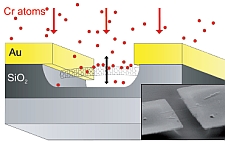European researchers have built a modern and sensitive device capable of weighing atoms. This facility could, in the end, allow scientists to examine the progress of chemical reactions - batch by batch

How can a single atom be considered? European researchers have built a state-of-the-art and sensitive device capable of performing exactly this task. This facility could, in the end, allow scientists to examine the progress of chemical reactions - batch by batch.
Carbon nanotubes are extremely thin fibers of carbon and represent the dream of every nanotechnologist. They consist of thin sheets of single-atom carbon - known by the scientific name graphene - rolled into a tiny tube that is only a few nanometers in diameter.
Scientific interest in carbon nanotubes blossomed and flourished in the nineties of the last century when they were discovered to have impressive properties that make them a fascinating raw material for diverse types of nanotechnologies.
"They have unique properties," explains Professor Pertti Hakonen from the Helsinki University of Technology. "They are a thousand times harder than steel and very good conductors of heat and electricity." The researcher is the coordinator of a scientific project whose goal is to utilize this fascinating material in order to develop devices sensitive enough to weigh atoms and particles.
A carbon nanotube is actually a very thin string, but still very rigid, and like other strings it is also able to vibrate and swing, similar to a guitar string. As any guitarist knows, heavier strings vibrate more slowly than lighter strings, so if we allow a suspended nanotube to vibrate at its characteristic frequency, this frequency will decrease if atoms or particles are attached to it.
It sounds simple and the idea is not new. However, the new thing is the sensitive sensing system required to detect the vibration and measure the exact frequency. Over time, it was discovered that certain nanotubes are capable of being semi-conducting, depending on the way the graphene sheets are rolled - and it is precisely this feature that allowed the researchers to find the solution they were looking for.
The researchers took the approach of building a semiconductor nanotube inside a transistor (a tiny electronic component used to increase voltage, power or current) so that the vibration modulates (electronically regulates) the current passing through it. "The oscillating nanotube is, at that moment, the vibrating component and is actually the input of the transistor," explains the researcher.
"Our idea was to activate three sensing planes at the same time and then choose the best among them," he adds. "At the moment we are down to only two. So we have the idea of electron movement, which is more sensitive, and the idea of the transistor affected by vibration, which is faster."
In November of the previous year, researchers from Barcelona, who are partners in this project, reported that they were able to weigh the mass of individual chromium atoms attached to a nanotube. However, the main researcher claims that today even smaller atoms, such as argon, can be considered, despite the fact that the device is not stable enough to obtain such a high sensitivity routinely.
"When the device is working properly, we are able to distinguish a single argon atom on a short time scale. However, if you continue and measure for a longer period of time, the background noise becomes more and more significant and obscures the result."
This venture is not the only one using carbon nanotubes as mass sensors. Similar research is also being carried out at two research centers in California - the University of Berkeley and Caltech - although each of them has adopted a different approach to mass sensing.
All three teams announced that they were able to measure mass at the atomic level using carbon nanotubes, but the researchers of the aforementioned project provided the most convincing information that presented a clear shift in the resonance frequency.
However, a single atom is not even close to the limit of the possible - the main researcher is convinced that they are able to advance the technology so that the mass of a single nucleon - a proton or a neutron - can be weighed with it.
"This is indeed a considerable difference," he admits, "but for the most part, the improvements in such devices are received in leaps and bounds. This is not like the development of a very well-known standard where there are only small improvements from stage to stage. This is really work at the forefront of the field and breakthroughs do happen - from time to time."
If it is indeed possible to improve the sensitivity down to a single nucleon, then researchers will be able to strive forward for accurate weighing of different types of atoms and particles in real time. Or then, it might be possible to observe the radioactive decay of a single nucleus and examine other types of phenomena in quantum mechanics.
However, the real excitement will come when it will be possible to monitor chemical and biological reactions involving individual atoms and molecules reacting right there, on top of the vibrating nanotube. Such a possibility could lead to many important applications in molecular biology and would allow scientists to examine basic processes of life in unprecedented detail. The researcher estimates that these practical applications can be accepted within ten years.
"This will greatly depend on the degree of development of the preparation of the carbon nanotubes itself. I cannot predict what exactly will happen, but I believe that chemical reactions in different systems, such as proteins and the like, will be the main applications in the future."

One response
Looks nice